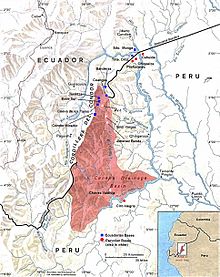Cenepa War
| Cenepa War | |||||||
|---|---|---|---|---|---|---|---|
| Part of the Ecuadorian-Peruvian Conflicts | |||||||
 Ecuadorian and Peruvian military outposts in the Cenepa valley, January 1995 |
|||||||
|
|||||||
| Belligerents | |||||||
|
|
|
||||||
| Commanders and leaders | |||||||
|
Alberto Fujimori Perú's Army General de Ejército Nicolás de Bari Hermoza Ríos 5th Jungle Infantry Division General de Brigada EP Vladimiro López Trigoso. |
Sixto Durán Ballén Theatre of Land Operations General Paco Moncayo |
||||||
| Casualties and losses | |||||||
|
Official losses: 60 killed (2 Mi-8T, 1 Mi-25) 4 aircraft (2 Su-22, 1 A-37B, 1 Canberra) |
Official losses: 34 killed and 70 wounded recognized by Comando Conjunto de las FFAA del Ecuador Peruvian claimed: 350 losses |
||||||
Official losses: 60 killed
Other sources:50 killed and 400+ wounded
The Cenepa War (January 26 – February 28, 1995), also known as the Alto Cenepa War, was a brief and localized military conflict between Ecuador and Peru, fought over control of an area in Peruvian territory (i.e. in the eastern side of the Cordillera del Cóndor, Province of Condorcanqui, Región Amazonas, Republic of Perú) near the border between the two countries (see map shown in the infobox). The two nations had signed a border treaty following the Ecuadorian–Peruvian War of 1941, but Ecuador later disagreed with the treaty as it applied to the Cenepa and Paquisha areas, and in 1960 Ecuador declared the treaty null and void.
Mediation efforts of Argentina, Brazil, Chile and the United States paved the way for the opening of diplomatic conversations that ultimately led to the signing of a definitive peace agreement (the Brasilia Presidential Act) on 26 October 1998. The peace agreement was followed by the formal demarcation of the border on 13 May 1999 and the end of the multi-national MOMEP (Military Observer Mission for Ecuador and Peru) troop deployment on 17 June 1999 which effectively put an end to one of the longest territorial disputes in the Western Hemisphere.
It is, as of 2017, the most recent military conflict in the Americas between countries contesting sovereignty over territory.
The Cenepa War was the most recent military clash between Ecuador and Peru over a long-standing territorial dispute that dated back to the first decades of the 19th century, when both countries came into being after the Wars of Independence of the Spanish colonies in South America.
In modern times there had been two previous military confrontations: a full-scale war in 1941, and a brief clash in 1981, both of which had seen the Peruvian military forces prevailing over the Ecuadorian military.
...
Wikipedia
